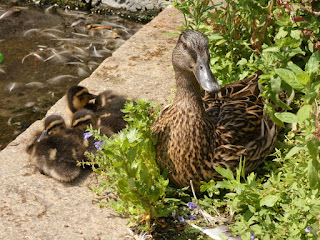A pair of Blackbirds near the Dell have three teenage offspring. They all foraged together on the lawn.
Their success contrasts with the misfortune of the pair of Mistle Thrushes here, which nested three times but each nest was raided by Magpies.
The Great Crested Grebes from the west end of the island were with their chick at the nest.
I couldn't see any eggs from the shore, but often they are hidden by the material of the nest.
The newly arrived grebes from the island have begun to split into pairs. One pair were displaying and making territorial calls.
One of the two chicks from the fallen poplar on the Long Water was by itself, practising fishing.
One of the third pair of grebes here could just be seen in the distance with the head of one chick showing. At this stage it's impossible to tell how many there are.
One of the Moorhen chicks in the Italian Garden fountain climbed about on the water lily leaves.
The single cygnet of the Mute Swans on the Long Water is now nearly adult size. It was beside one of the air bubblers, which probably don't do much to increase the amount of oxygen in the lake but do bring up a lot of silt from the bottom, possibly including edible creatures.
The Mallard with three ducklings on the Serpentine kept them in a safe place behind the railings of the small boathouse.
The Tufted Duck on the Serpentine still has one duckling, which was sticking close to its mother.
The number of Cormorants on the Long Water is beginning to rise as this year's young fish grow to a size worth catching.
There was a swirl of Black-Headed and Herring Gulls over the island, with the inevitable cranes in the background -- not the interesting kind of crane.
One of the pair of Lesser Black-Backed Gulls that hang around the Lido restaurant, not seen for some time, has come back. This may mean that the pair has been nesting on a flat roof somewhere. We shall see if a young one turns up with the other adult.
An Emperor Dragonfly settled for a moment on an iris leaf.
Mark Williams was in St James's Park and got a very interesting picture of a Grass-Carrying Wasp, Isodontia mexicana.
This North American species only arrived in Britain a couple of years ago. It's a solitary wasp which lives on grasshoppers and crickets, and builds a nest in a cavity such as a hollow stem, which it lines with grass.













What a strange sort of wasp. I wonder if they will thrive in England.
ReplyDeleteI was hopeful when reaching the word "crane", and then I found that English polysemy worked to my disadvantage.
If only ...
DeleteI have seen a stork in London, but never a crane.
Lovely photo of the Emperor. They don't often pose like this.
ReplyDeleteFascinated by the wasp which I've never heard of. I wonder how common it is here? I don't recall seeing it before.
Apparently the first one in this country was seen in Greenwich Peninsula Ecology Park in January 2017.
DeleteThanks for that, Ralph.
ReplyDelete